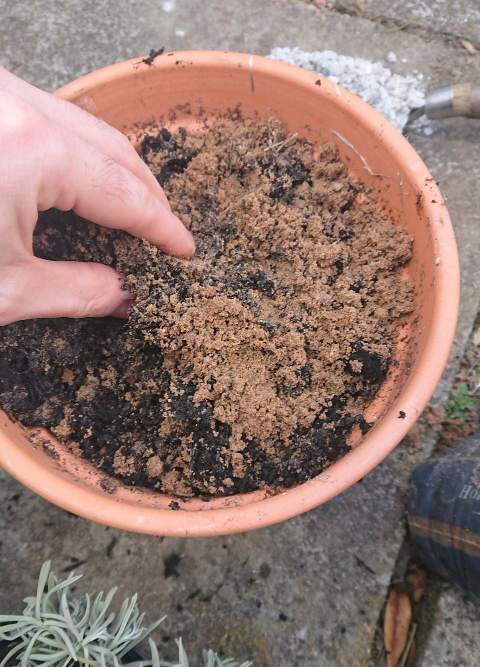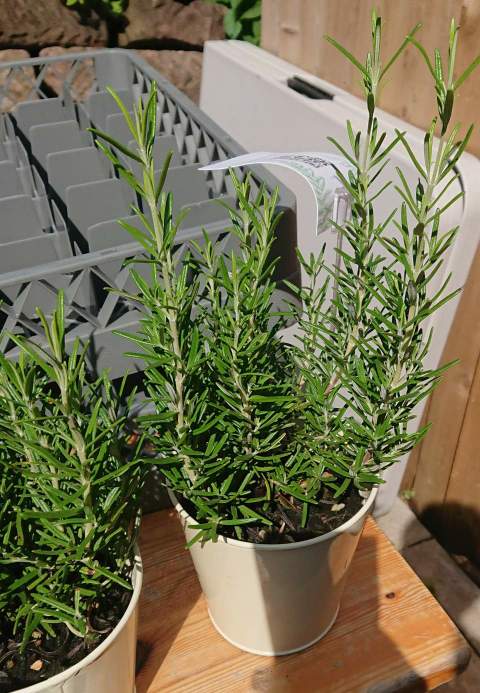
Although overwatering is the most frequent cause of potted rosemary plants dying, choosing the right potting soil is just as crucial as following an ideal watering schedule since if the rosemary’s roots are placed in potting soil that retains a lot of moisture, this can still lead to root rot.
To grow properly and yield the greatest aroma, rosemary needs potting soil that drains rapidly, doesn’t retain a lot of moisture, and has only moderate fertility. To make the ideal potting mixture for rosemary, aim for a ratio of two thirds compost and one third horticultural sand.
Learn how to make the best potting mix, why peat moss is bad for plants, and how to plant rosemary correctly by reading on.
Table of Contents
Criteria for Good Potting Soil for Rosemary Plants
- soil with good drainage and pores that do not retain rainwater for too long.
- a soil structure that is aerated, enabling effective root respiration (rosemary does not like compacted soil).
- Soil with a medium to low fertility.
- To grow rosemary, soil must be rich in inorganic particles (similar to the sandy, gritty soils of its native environment).
The herb rosemary is native to the Mediterranean region of Southern Europe, where it naturally grows on the slopes of mountains in Spain, Portugal, and France.
Rosemary flourishes in sandy or rocky soils that are generally low in nutrients, drain very fast, and hold little moisture in its hillside habitat.
Hillsides naturally provide adequate drainage, and the grity, aerated, porous soils make sure that too much moisture doesn’t collect around the roots, as this can encourage root rot, one of the most frequent issues that rosemary farmers face.
The likelihood of a fungal disease impacting your rosemary is increased by soils that retain a lot of moisture, such as clay soils or modified compost containing wetting agents. This disease can cause your rosemary’s leaves to turn yellow, brown, or black and cause it to wither and die.
(Read my essay on how to save a rosemary plant from extinction.)
In contrast to the low fertility, grippy, sandy soil conditions to which the rosemary has specifically adapted, soils that are rich in nutrients, such as loam soil, compost with added fertilizers, or soil that has been amended with manure (which is very high in nitrogen), should not be used to grow rosemary.
Rosemary tends to droop in nutrient-rich soil, and more nitrogen in the soil lowers the concentration of essential oils in the leaves, which are what give rosemary its particular flavor and perfume. Because of this, rosemary won’t taste, smell, or produce as many blossoms if you put it in fertile soil.
Since pots have good drainage characteristics, which resemble the well-draining conditions that naturally occur on hillsides, rosemary actually grows quite well in pots and containers.
The secret to maintaining healthy potted rosemary in your yard is to mimic the Mediterranean region’s porous, well-draining soil…
How to Create the Perfect Potting Soil for Rosemary

It’s crucial to replicate the sandy, grippy, medium to low fertility soil conditions found in rosemary’s natural Mediterranean setting if you want to grow it in pots.
This can be accomplished by adding coarse horticultural sand or grit to regular multipurpose compost.
The horticultural sand and grit closely resembles the inorganic component of rosemary’s natural soil, which is very sandy and stony. This mimicry ensures excellent drainage, a porous structure that creates space for oxygen in the soil, which is important for root respiration, and a prevents any soil compaction that could slow drainage.
Mix at least 30% horticultural sand or grit with 70% compost to successfully imitate the Mediterranean soil of rosemary.
Too much sand or grit is always preferable to not enough since it greatly reduces the likelihood of root rot, which is the most typical cause of dying rosemary plants.
I advise adding more sand or grit to the soil if you reside in an area with more rainfall, such as the Pacific Northwest or Northern Europe.
It is crucial to stress how much rosemary depends on well-draining soil since it has specifically evolved to endure drought and dry soils.
Once your rosemary is flourishing in its preferred well-draining circumstances, adding extra sand or grit to the mix will assist to counteract the effect of high rainfall regions. Your rosemary should grow quite well after that.
Commercial growers of rosemary, lavender, and other Mediterranean herbs in Washington and Oregon who I spoke with advise amending potting soil with up to 50% horticultural sand or grit and 50% multipurpose compost to create the ideal drainage mix for growing rosemary successfully despite rainy weather.
Another crucial function that the sand and grit play is in helping to achieve the ideal level of soil fertility for rosemary.
As strange as it may sound, rosemary grows well in low-fertility soils and produces the most blooms as well as the best perfume and flavor in the leaves.
In order for your potting soil to replicate the same level of soil fertility as their Mediterranean range and give your rosemary the best flavor and scent, sand and grit do not add many nutrients to the soil. This helps to balance out the fertility of the compost.
The grittier compost mixture has all the nutrients that the rosemary needs.
Do not make this error!
It’s crucial to know that you cannot use regular beach sand in place of horticultural sand in your rosemary potting mixture.
Compared to typical beach sand, which contains considerably smaller grains, horticultural sand is coarser and has a greater particle size.
The increased size of the horticulral sands allows more air into the soil and more effective water drainage.
Beach sand can have very minute particles, which might result in a soil mixture that drains too slowly and prevents oxygen absorption due to its less porous structure.
Garden supply stores and online retailers frequently offer horticultural sand, grit, or perlite for reasonable prices.
(Read my post on selecting the ideal pots for rosemary.)
Avoid Amending Rosemary Potting Soil with Peat Moss
Avoid peat moss because it dries out into a hydrophobic substance that repels water from the surface of potting soil and bakes hard in full light (rosemary needs full sun). As a result, water may run off the top of the soil and down the side of the pot instead of penetrating the soil and reaching the roots.
Although rosemary is a drought-resistant plant, it can suffer from regrowth if water is being reflected off the soil’s surface and away from the roots, which are unable to absorb any moisture.
When making your potting mix for rosemary, always emphasize a peat-free compost or potting soil, which should be identified clearly on the container.
Aside from the peat content, you should avoid planting rosemary in compost that has wetting agents or additional fertilizer because both of these qualities are not compatible with the soil conditions that rosemary prefers.
The best potting soil for rosemary is regular multipurpose compost that has been altered with sand or grit.
(Read my post on how to water rosemary for all the best watering techniques.) It’s crucial to know when to water potted rosemary in order to complement well-draining soil and maintain the ideal balance for moisture for potted rosemary.
Potting Soil pH for Rosemary
Rosemary prefers a pH range of 6 to 7.5 (which is slightly acidic, neutral, and slightly alkaline), however some cultivars can tolerate a pH range of 4.3 to 8.3. Rosemary is native to areas with calcareous soils, which are often alkaline in pH.
Except for potting soils that are marked as ericaceous, which signifies they were made for plants like camellias that prefer greater levels of acidity, all commonly found commercially available potting soils and compost fall within the recommended pH range of 6-7.5.
It is not necessary to add lime or any other substance that causes the pH to rise to an alkaline level to the soil. While it might not affect the rosemary, adding too much could potentially be harmful.
(Read my post on maintaining rosemary plants in pots.)
